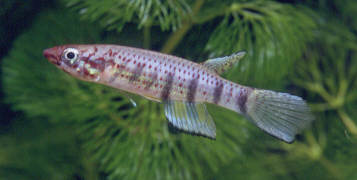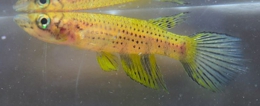Epiplatys multifasciatus (Boulenger 1913)

E.boulengeri
?(multifasciatus). Wild male collected
at Leconi, Gabon.
Photo courtesy of Ed Pürzl.
| Meaning of Name |
Refers to the multiple stripes on the body. |
|||
| First Description |
Boulenger G.A. 1913. Description de deux poissons nouveaux provenant des récoltés de Mr. E. Luja à Kondué, Kasai. Monatsberichte der Gesellschaft der Luxemburger Naturfreunde (Bulletins Mensuels de la Societe des Naturalistes Luxembourgeois) 7 (7): p 43. |
|||
| Size |
7 cm |
|||
| Meristics |
|
|||
| Karyotype |
|
|||
| Sub-Genus |
Epiplatys |
|||
| Group |
multifasciatus clade |
|||
| Synonyms |
|
|||
Populations
|
GBN 80 / 20 - Imported by BKA Species Import Committee June/July 1981. |
|||
| Type Locality |
Kondoué, Kasai Province, southern Zaire. |
|||
| Distribution |
Widespread throughout the Zaire River drainage system. http://homepage.uibk.ac.at/homepage/c102/c102mr/epiplaty/multifas.htm |
|||
| Habitat |
Rainforest streams, small rivers & brooks. They are known to feed on terrestrial insects (sometimes large) especially ants. Reproduction is throughout the year. Water analysis from Yangambi, Central Congo drainage, is temperature 23-24'C, pH 3.6-4.0 which is quite acidic. See A.rectogoense for biotope photo. |
|||
| Distinguishing Characteristics | ||||
| Colour/Pattern Variability | High | |||
| History |
Boulenger described this species as Haplochilus multifasciatus from 6 specimens collected at Kondue, Kasai, Congo. In 1915 he included a line drawing in his catalogue. These specimens are not adult & 'rather slender' according to Huber. In 1917 Nichols & Griscom collected the species in 'pools & in a clear running forest river' which was an affluent of the Tschopo River. In 1936 Fowler collected them from Batangafo, Ubangi-Shari (Uam-Fara District close to the upper reaches of Bahr-Sara). Also from a locality some 30 km to the east of Kribi, southern Cameroon. Poll, in 1952, placed Haplochilus boulengeri as a synonym of E.multifasciatus. This was based on specimens collected from rivers in the Central Congo drainage area (except for Katanga & the upper drainage of the Congo River). In 1959 he reported them as being found in the Stanley Pool area. Lambert, in 1961, reported them from the eastern area of the Central Congo drainage (Banalia, Ikela, Lomela, Opala, Stanleyville & Yangambi districts). These he considered to represent a subspecies of sexfasciatus. Gosse, in 1963, collected them at Yangambi where he found them common in brooks & forested swampy areas. He noted that these were found near the surface in shallow parts. In 1964 Matthes reported them from Lake Tumba & Ikela districts. History of the synonym Haplochilus boulengeri Pellegrin described the now synonymous
Haplochilus boulengeri in 1926 by
one specimen collected at Kidada, three from Mongende, & three from
Tshimbu, Central Congo drainage. |
|||
| Breeding Notes |
The ease of breeding this species is dependant on the differing populations. Some are easy whilst others are more difficult. Reports suggest using a large aquarium with one male & several females. Top mops are used for breeding. Eggs should be picked regularly & incubated in a seperate container. Water incubation takes 11-15 days. Growth rate is quite fast with sexual maturity being attained around 6 months. |
|||
| Diameter of Egg | ||||
| Remarks |
Some authors prefer to call Epiplatys boulengeri a full species. This work has followed the work of Wildekamp in 'A World of Killies' Volume III. |


